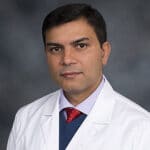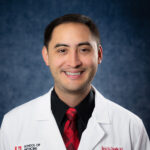Treatments and services
Diseases of the aorta and aortic branches
We provide a complete continuum of care for all types of aortic conditions, including aortic dissections (occurs when a tear in the inner wall of the aorta causes blood to flow between the layers of the wall of the aorta and force the layers apart), thoracic aortic aneurysms, abdominal aortic aneurysms (AAA), traumatic aortic rupture and injuries, mesenteric ischemia (inflammation and injury of the intestine result from inadequate blood supply) and aortoiliac occlusive disease. Treatment options range from medical management and minimally invasive procedures to hybrid therapies and open procedures (traditional surgery).
Cerebrovascular disease
Cerebrovascular disease refers to a group of conditions that affect the circulation of blood to the brain, causing limited or no blood flow to affected areas of the brain. The results of cerebrovascular disease can include a stroke. Our vascular surgeons provide comprehensive evaluation and management of patients with cerebrovascular disease, including:
- Carotid endarterectomy: A surgical procedure to prevent a stroke by correcting the narrowing of the carotid artery and removing the plaque that has built up on the inside of the artery.
- Carotid artery stenting with embolic protection: A minimally invasive procedure that uses catheters to unblock the narrowing of the carotid artery lumen to prevent a stroke.
- Bypass procedures that reroute needed blood flow to the brain.
Peripheral artery disease
Peripheral arterial disease (PAD) is a disease in which plaque builds up in the arteries that carry blood to your head, organs and limbs. Plaque is made up of fat, cholesterol, calcium, fibrous tissue and other substances in the blood. When plaque builds up in the body’s arteries, the condition is called atherosclerosis (hardening of the arteries). Over time, plaque can harden and narrow the arteries. This limits the flow of oxygen-rich blood to your organs and other parts of your body. While PAD usually affects the arteries in the legs, it also can affect the arteries that carry blood from your heart to your head, arms, kidneys and intestine.
Our surgeons offer a variety of treatment options for PAD, including:
- Medical advances
- Endovascular therapies such as:
- Balloon angioplasty includes (freezing) cryotherapy and cutting-balloons
- Angioplasty with stenting
- Recanalization of total occlusions
- Atherectomy – “ roto-rooter” blocked vessels
- Bypass procedures
- Endarterectomy including remote, single-incision endarterectomy
- Hybrid or combination procedures
- Thrombolytic therapy – the use of drugs to break up or dissolve blood clots
Acute venous thromboembolic disease
Venous thrombosis is a blood clot (thrombus) that forms within a vein. Thrombosis is a medical term for a blood clot occurring inside a blood vessel. The most common venous thrombosis is deep vein thrombosis (DVT), which can break off and become a life-threatening pulmonary embolism (PE). The conditions of DVT and PE are referred to collectively with the term venous thromboembolic disease. We offer a variety of minimally invasive treatment options for venous thromboembolic disease, including:
- Catheter-directed thrombolytic (clot-busting) therapy
- Mechanical thrombectomies (removal of clot)
- Rheolytic thrombectomy (Angiojet)
- Placement of vena caval filters
- Removal of vena caval filters
- Venous stenting and balloon angioplasty
Chronic venous disease
Venous problems are common. If you suffer from unsightly spider veins or painful varicose veins, UofL Physicians – Vascular can help. Our highly skilled vascular surgeons combine their clinical expertise with the most advanced cosmetic and surgical techniques to achieve dramatic results without drastic measures. The results are legs that are more natural and youthful in appearance. Most treatments are performed in the privacy and comfort of our clinic usually under local anesthetic. The recovery time is brief. We offer a variety of treatment options for chronic venous disease, including:
- Endovenous laser ablation of varicose veins (EVLT)
- Radiofrequency ablation of varicose veins (closure)
- Sclerotherapy
- Veinwave
- Micro-phlebectomy
- Embolic therapy (block unwanted venous connections)
- Venous bypass procedures
Hemodialysis access
If you are starting hemodialysis treatments in the next several months, you need surgery for vascular access, which is the site on your body where blood is removed and returned during dialysis. To maximize the amount of blood cleansed during hemodialysis treatments, vascular access should allow continuous high volumes of blood flow. We offer a variety of options for hemodialysis access, including:
- Creation of all types of AV fistula (creates a passageway between an artery and a vein)
- Creation of complex (exotic) access when other sites have been used
- Placement of long-term and temporary dialysis catheters
- Fistulogram, angioplasty and stents (minimally invasive maintenance of access for long term use)
- Access thrombectomy (by catheter and by surgical techniques)
Diagnostic services
When it comes to vascular disease, early detection can reduce the risk of serious complications. That is why our practices put a strong emphasis on diagnosis. We use the most advanced, non-invasive vascular testing, including:
- Duplex ultrasonography: Determines multiple factors within the circulatory system. It can evaluate central (abdominal) and peripheral arteries and veins. It helps determine the amount of vascular stenosis (narrowing) or occlusion (complete blockage) within an artery. It also assists in ruling out aneurysms and it is the main aid to rule out thrombotic events.
- Doppler and plethysmography
- Ankle-brachial indices to determine blood flow
In an effort to prevent vascular events, like aneurysms or strokes, from occurring we also offer diagnostic vascular screenings at multiple facilities for just $53. Since vascular conditions do not always present with symptoms, a 30-minute screening could help detect a problem before it occurs. Simply call 502-587-4327 to schedule a screening today.


 UofL Health – South Hospital
UofL Health – South Hospital









